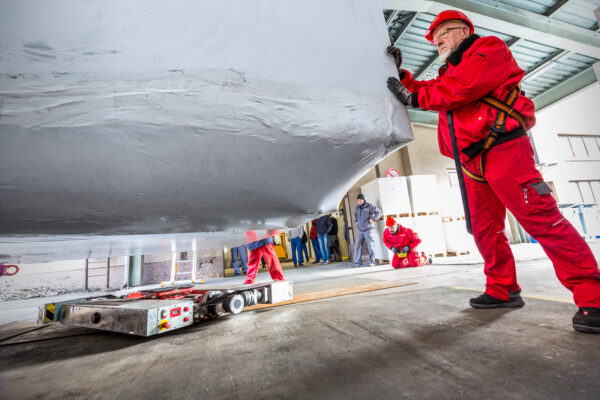The individual components and parts of a printing press are heavy. The feeder, printing units, coating unit and sheet delivery weigh a total of almost 170 metric tons. The dimensions of many presses are also impressive: 24 meters long, 6 meters wide and 4 meters high. To transport all the components safely to the final location, one of the vehicles SCHOLPP works with is the ROBOT-40 transport system. This consists of two components: the steerable front part, equipped with electronics and a motor drive, and the rear part with wheels and a rigid chassis.
The ROBOT-40 transport system made its debut moving in and installing printing presses for a well-known German printing press manufacturer. “For this machine manufacturer, we move between four and twelve components of different weights per assignment. The ROBOT moves the parts individually through the hall in a defined sequence to their destination,” says Stefan Creutzburg from the materials management team in Erfurt, describing the procedure. As soon as the installation of the first component starts, the second is already on its way. With space in the halls being tight, only one ROBOT-40 is normally in use at a time.
Driving and steering like in a car
Before this special chassis can start its in-plant duties, the load to be transported, with a maximum weight of 40 metric tons, must be raised at least 26 centimeters. Alternatively, it can be lowered with pinpoint accuracy by a truck-mounted crane or lifting gantry. The SCHOLPP team then moves the load to the desired location and positions it there.
The ROBOT-40 is flexible and suitable for use anywhere, as it can drive around curves as well as backward with a heavy load. The control unit is usually located at the front and is positioned at the rear only in particular circumstances. Stefan Creutzburg draws a simple comparison here: “Basically, the ROBOT-40 works like a car, which is also steered from the front.” And what is the biggest plus about its efficient use? “Without a doubt, the ability to drive and steer at the same time,” says Creutzburg.
Navigation in the hall
The operator navigating the ROBOT-40 via a portable radio control can closely monitor every move. “A forklift driver always has to get out first to see if everything fits,” explains Stefan Creutzburg. “With the ROBOT-40, the employee can walk behind it, next to it or in front of it, meaning they can keep an eye on everything at all times.” The operator uses two toggle switches for forward and reverse travel and can also choose between two travel speeds. The hare and tortoise symbols on the control panel illustrate the speed mode. “For empty runs, the operator switches to the hare for walking pace; when transporting a load, they switch to the tortoise,” says Creutzburg. The ROBOT-40 is therefore rarely in continuous operation, so it can run for up to six hours with the built-in lithium-ion batteries.
It is mainly used indoors because the sensitive electrical system has to be protected against rain, wind and other weather conditions. In addition, the surfaces need to be as smooth and as flat as possible for the transport. The ROBOT-40 cannot move across transverse joints, stones, bumps, ridges or other uneven surfaces. In the worst-case scenario, the load could tip over. “If the weather and ground conditions are right, the system can conceivably be used outdoors, too, but that’s the exception rather than the rule,” says Creutzburg.
First theory, then practice
SCHOLPP now has three ROBOT chassis in use – two large models for moving up to 40 metric tons and a smaller one for up to 20 metric tons. At the company’s Erfurt site, a ROBOT-40 is available for training in theory and practice. “Before they’re allowed to operate this industrial truck on construction sites, SCHOLPP employees must first attend a training course at our academy,” explains Stefan Creutzburg. Other than that, the ROBOT-40 is out and about throughout Germany on SCHOLPP’s behalf. If a project is pending, the two components are packed into a transport crate and sent on their way to the customer’s project. To make sure any damage or defects are detected immediately after its return, SCHOLPP inspects the ROBOT-40 after each assignment. A short test drive, for example, reveals whether the wheels are still in perfect condition. “It’s enough to drive through traces of oil or over small stones and screws,” says Stefan Creutzburg, naming three possible causes of tire wear. In addition to these situational checks, the vehicles are inspected once a year in accordance with the applicable statutory accident prevention regulations, ensuring that the ROBOT-40 transport system is able to continue moving printing presses and other heavyweights safely to their desired destination within the works in the future.


Leave A Comment